Mixing up your Open Water Swims with Specific Drills and Skills
 Karen Parnell
July 29, 2020
Karen Parnell
July 29, 2020
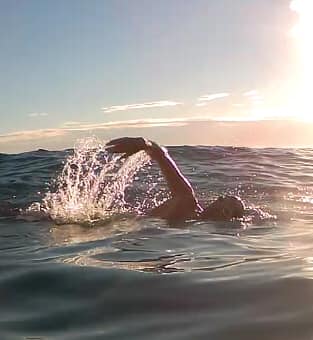
Mixing up your open water swims with specific drills and skills
There's nothing quite like swimming outdoors and enjoying the fresh air and total connection to our environment. One of the things I love most about swimming outdoors is that unlike a swimming pool you can overload your body sensors with smells, sound, temperature variations and sometimes tastes plus a visit from the odd wildlife. You can get totally absorbed in the moment and have some really natural mindfulness. Sometimes I like to just float on my back and watch the sky or is that just me?
But sometimes it is time to just get out there and get the endurance work in if you are training for an event but given the current situation many will not have races and therefore no training focus. This is the time we may need some structure in our swim sessions and there is no better time than to sharpen our open water skills and make sure our kit is optimised for the absolute best experience.
Here’s a FREE Swim Workouts for Triathletes Book with swim workouts, tips, technique, drills, kit and terms.
.jpg)
Orca wetsuits are ideal for open water swimming - super flexible Photo by Orca on Unsplash
Get your FREE Open Water Swimming Sessions E-Book
Kit for Open Water Swimming
We all have our favourite wetsuit and goggle brand, and this is very personal. For me, its Orca (extremely flexible and easy to get in to and more importantly get out of!) and Zoggs Predator Flex goggles. But I’m sure you have your favourites.
The one product that I always use and never lets me down is Cressi anti-fog, it works and works extremely well! Developed for deep sea divers’ masks it makes light work of keeping my goggles fog free in the pool, lake and sea. I’ve heard people recommend things like baby shampoo and other more exotic concoctions, but I would recommend using the product designed for the job and it doesn’t cost much. After all would you use vegetable oil to lubricate your bicycle chain? Once you discover this product your swims will be so much more enjoyable, less frustrating and not to mention clear.
You will also find a lubricant like Body Glide will help prevent wetsuit chaffing and help you get out of your wetsuit easily. Apply it to your neck, wrists and ankles. Again use a product made for the job rather than Vaseline which could decay your wetsuit and is an open water pollutant.
It's a good idea to also wear a brightly coloured swimming hat (like the ChiliTri swimming hat) and tow float to ensure other water users like the dreaded jet skiers can see you!
Here’s a FREE Swim Workouts for Triathletes Book with swim workouts, tips, technique, drills, kit and terms.
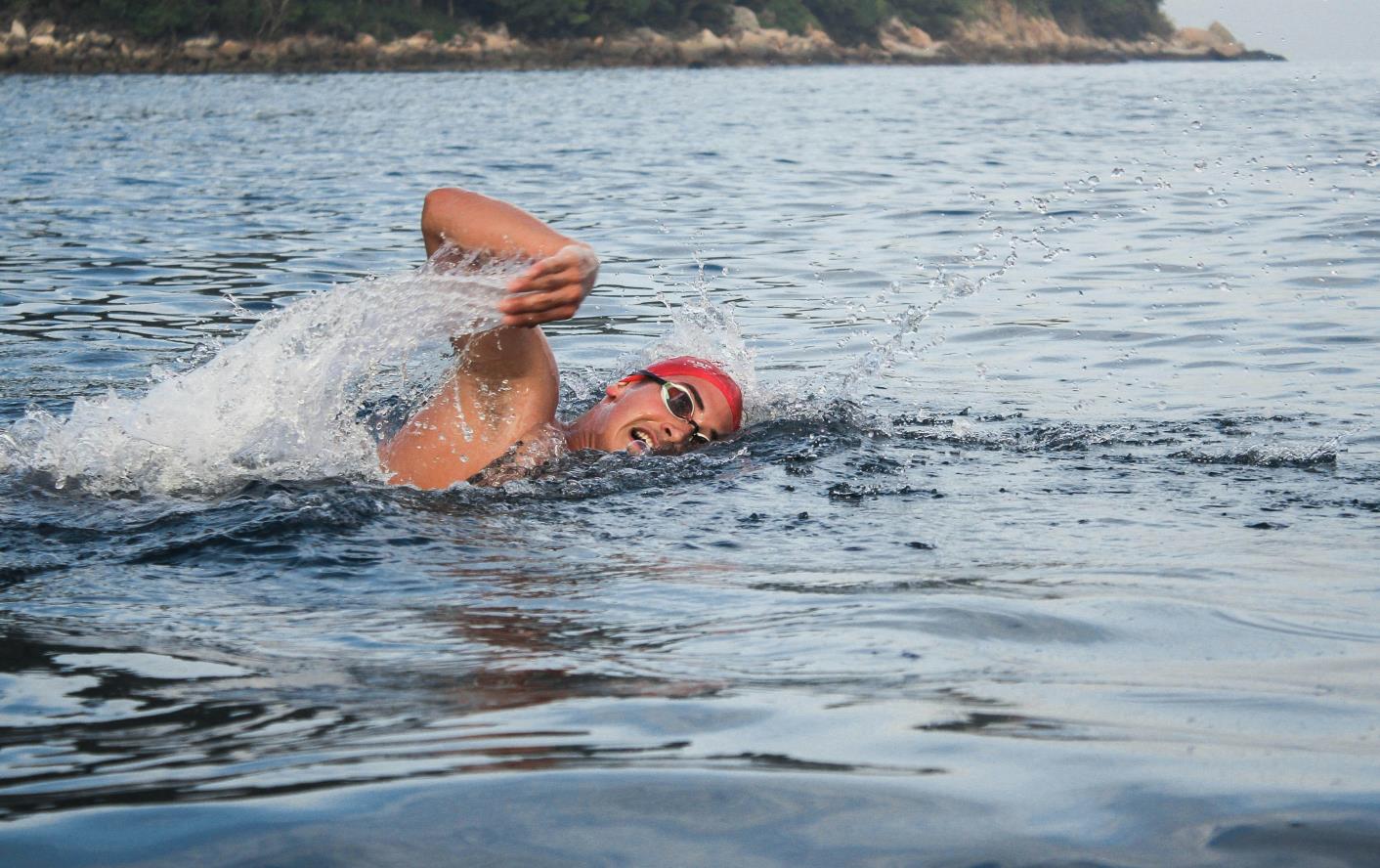
Choosing the right goggle is key - Zoggs Predator Flex are my favourite Photo by Alejandra Ezquerro on Unsplash
Get your FREE Open Water Swimming Sessions E-Book
Essential Open Water Swimming Skills
You can practice your open water swimming skills in the open water and in the swimming pool so there's no need to wait until the warmer temperatures to practice them.
Here are the essential open water skills you can practice now such as sighing, drafting, buoy turns and bi-lateral breathing.
Sighting
One of the most important skills to master is sighting and it’s currently even more important as we have to social distance even in the open water.
To gracefully take a “peak”, breath and not impact our streamlined body position is a skill well worth perfecting. This will enable us to keep our speed up and back safe. Avoiding the dreaded banana back!
The first step is to plan what you will sight on. In a race this is usually a brightly coloured buoy. It’s a good idea to take a look at the course and familiarise yourself with the sequence and colours. In a lake or sea training scenario then take some time to pick a large object that won’t move. You will have heard anecdotes of swimmers choosing fishermen to sight on! They have a habit of packing up when swimmers arrive. I usually choose a large rock formation or tree.
If you are practising this in the pool you can sight on a pull buoy, water bottle and more.
The trick to efficient sighting is to just lift your eyes above the water and take a peek at the object you pre-chose to sight on then turn to the side and breath as normal – some call is crocodile or alligator eyes.
Don’t worry if you don’t see what you want to sight first time as with good technique you can keep sighting and not impact your speed too much. The key is to extend your arm press down very slightly, look with eyes just above the water then turn to breath in one smooth motion – don’t breath to the front.
You will probably have a preference on breathing side to it’s more natural to use that side for sighting. If you push down too hard, raise your head and breath to the front your hips will sink, and you will slow down. You may even take a breaststroke at the front, swallow and loose most of your momentum.
Here’s a FREE Swim Workouts for Triathletes Book with swim workouts, tips, technique, drills, kit and terms.
Sighting = Arm extend – peak – turn head & breath to side – continue with normal stroke
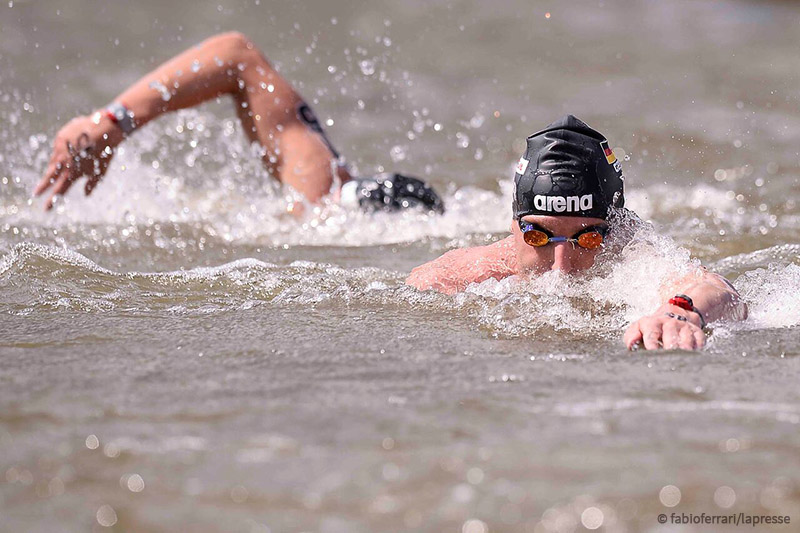
Open Water Swim Sighting - just take a peak!
Get your FREE Open Water Swimming Sessions E-Book
Drafting
Drafting is like catching a free ride in the swimming world and can save your energy and keep you fresher for the bike leg. Studies indicate that maintaining a distance of 50 cm behind a fellow athlete can result in a significant 21% reduction in drag coefficient.
Additionally, swimming alongside another athlete may lead to a drag reduction of approximately 7%. In events like the Olympic or IRONMAN Triathlon, adopting these drafting techniques could potentially save you up to two valuable minutes.
Pair up with a buddy in the lake, sea or swimming pool and take turns leading. This simulates the close-quarters swimming you’ll encounter during the chaotic start of an open water race. Practice communication and maintain a steady pace for an added challenge.
There are various forms of drafting which you can practice such as toe, hip or diamond formation. For the toe drafting swim behind another swim and practice getting as close as you can to their toes. Try tapping their toes to make sure you are as close as you can be for the maximum tow and also help them get used to the feeling as it will happen in a race - the key is not to get put off or annoyed by this and concentrate on your swim stroke and race.
You can also practice drafting on the hip and this is a good one to get right. Swim side by side with your swim buddy then slip down so your head is in line with their hip. Synchronise your arm stroke with your buddy and enjoy a tow from them.
You can also practice triangle formation drafting if you have three swimmers or diamond formation if you have four swimmers. For triangle drafting position two swimmers on the hip of the lead swimmer and synchronise your arm strokes so you don't clash. For the diamond formation set up the triangle as before then add in a extra swim on the toes of the lead swimmer to form a diamond.
These are also useful and fun ways to practice essential open water swimming skills but in a fun way.
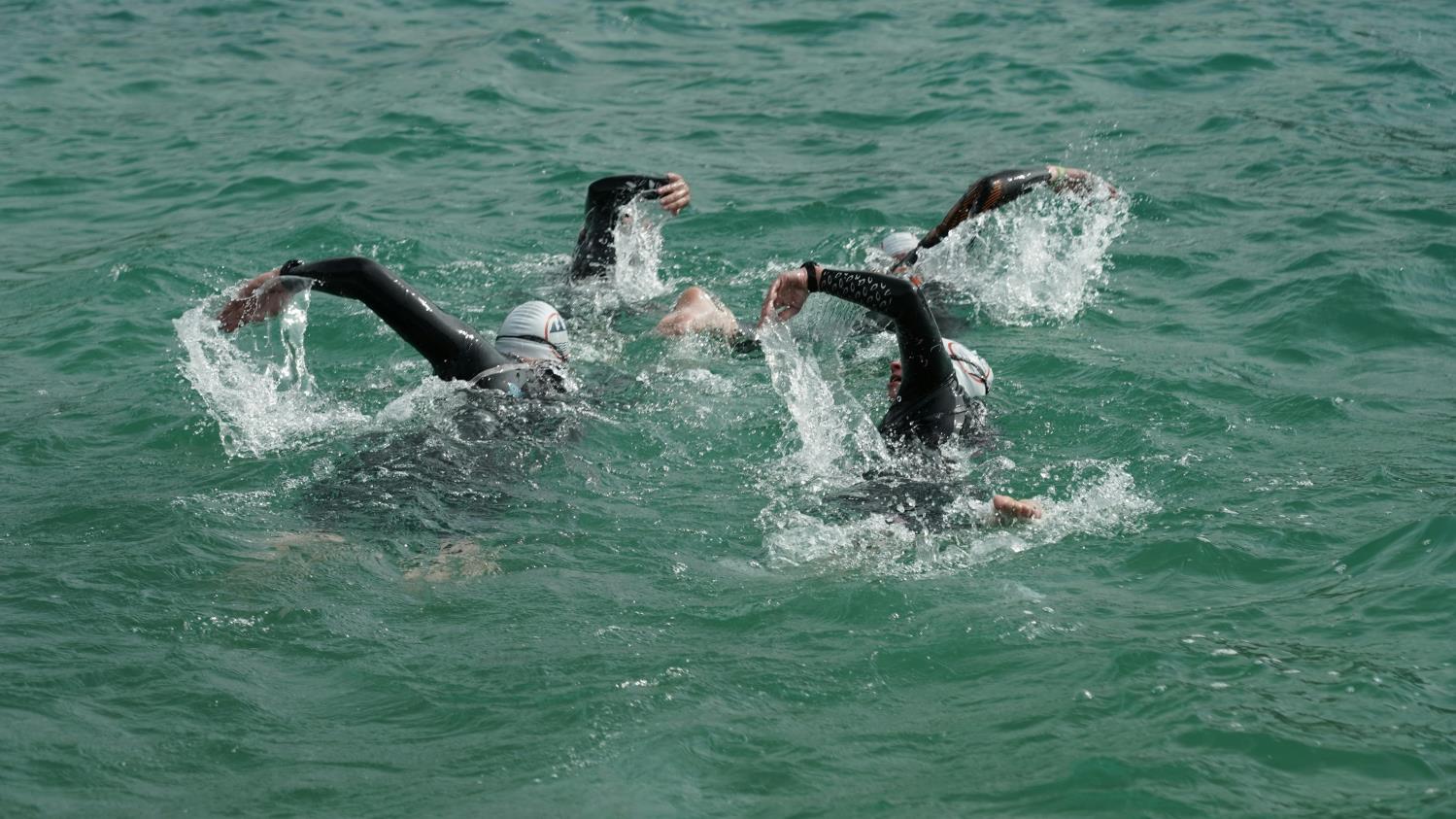
Diamond Formation Swim Drafting Photo by Johanna Steppan on Unsplash
Get your FREE Open Water Swimming Sessions E-Book
Bi-Lateral Breathing
Bi-lateral breathing is a good skill to learn as it will help you swing straighter with a more balanced stroke plus give you a plan B if there is a wave or swimmer in the way of you taking a breath to your favourite side.
If you can breath to both sides naturally you will always be able to take a breath when you need it.
A simple way to practice bi-lateral breathing is breathing ever 3, 3, 5, 5, 7, 7 strokes and keep repeating this.
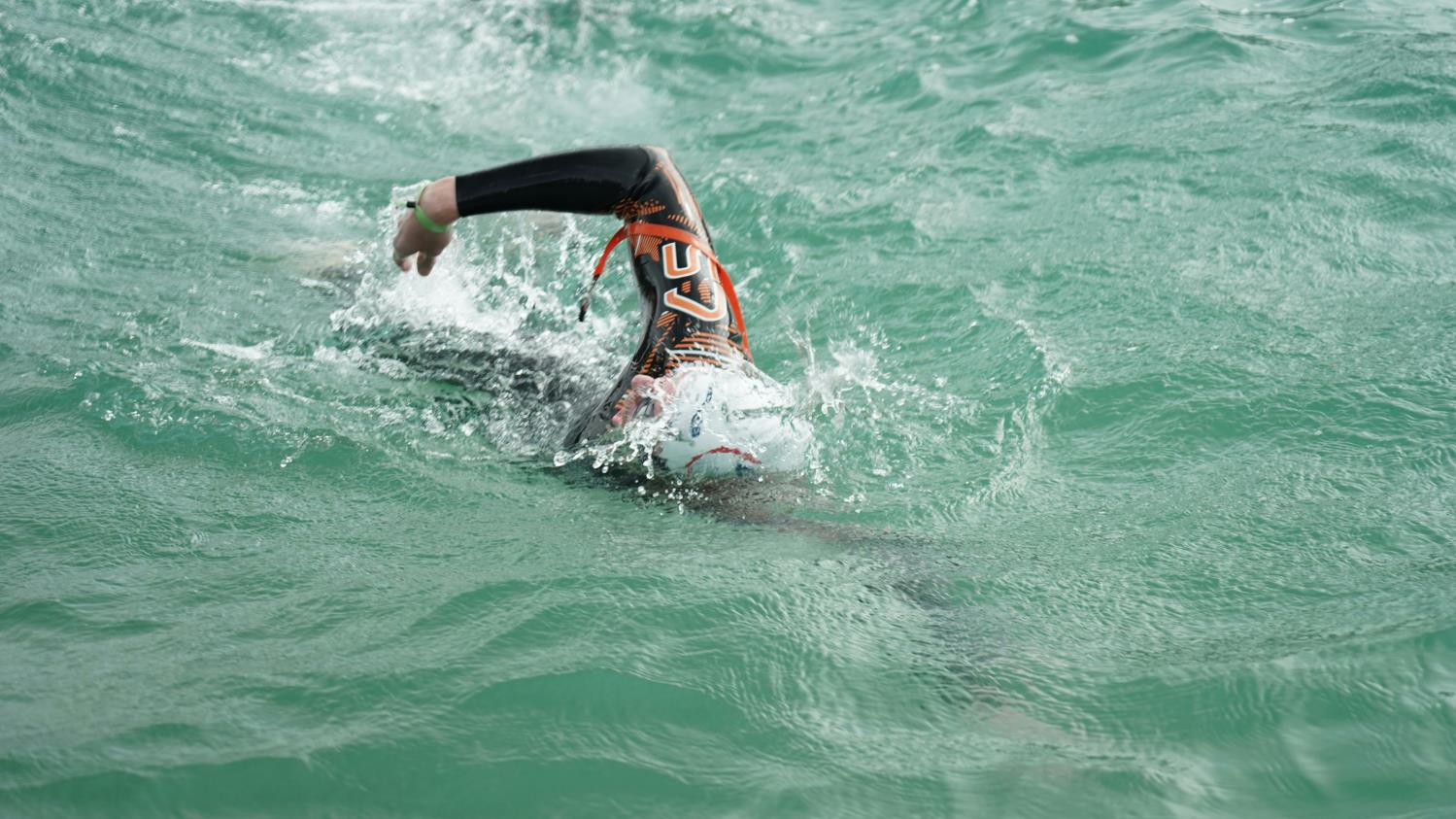
Bi-lateral breathing is an essential skill for open water swimming Photo by Johanna Steppan on Unsplash
Get your FREE Open Water Swimming Sessions E-Book
Open Water Swimming Session for Sighting
Here’s an example of a training session you may like to try to perfect your sighting technique:
SESSION FOCUS
This session focusses on honing your sighting technique.
Distance: 1750m
EQUIPMENT
Wetsuit, Body Glide lube, goggles, tow float & Cressi anti-fog
WARM UP
- Single arm rotations: forwards and backwards left and right x 10. Then one forward and one backward x 10
- Chest hugs x 10 (bent over)
- Arm spinning, side to side, bent over left and right x10
- Arm spinning as above but standing x 10
- Double arm swings with knee bends – 10 forward and 10 backwards
Splash face with cold water with goggles off and then face in and exhale into water. Open wetsuit neck, wrists and ankles & let water in.
5 mins of approximate 50s of repeated drill into freestyle:
1. 10m scull #1 into 40m freestyle B3s (light flutter to keep feet high if necessary)
2. 10m scull #2 into 40m freestyle B3s (light flutter to keep feet high if necessary)
3. 10m new doggy paddle into 40m freestyle B3s (light flutter to keep feet high if necessary)
4 x 50m deep water sprint starts
Yes you can do drills in open water – it’s fun!
Warm up = 350m
MAIN SESSION
One lap of your course is ideally 400-800m.
4 x 20 strokes eyes closed no sighting – which way to do you veer off to?
3 x 400 as (or 40-80 strokes if open water for 100m):
1. 100 sighting every breath (left) + 300 settle into sighting every 2 breaths B2s +30s
2. 100 sighting every breath (right) + 300 settle into sighting every 2 breaths B2s +30s
3. 400 B3s sighting every 2 breaths swap to sight on other breathing side halfway
Which side to you find it easies to breath after sighting peak?
Main session = 1200m
WARM DOWN
200 easy swim back to shore.
Warm drink and catch up catch with your fellow swimmers (socially distanced of course).
FREE Swim Workouts for Triathletes Book with swim workouts, tips, technique, drills, kit and terms.
Use your Pool Swims to Practice Dealing with the Unexpected Race Day Events
On race day, when your heart's racing and the adrenaline's pumping, even a minor mishap like having your goggles knocked can feel like a major setback. But fear not, because the pool isn't just for laps—it's your ultimate training ground for handling race-day curveballs.
To simulate getting your goggles kick you could fill your goggles halfway with water in the pool so you can get a feel for what it's like if they take a hit. It's not just about getting used to the sensation; it's about mastering your response. Do you keep them on and flip to backstroke to clear the water? The only way to know for sure is to dive in and try it out.
By using your pool sessions to simulate race-day scenarios, you're not just swimming laps; you're preparing for the unexpected. Whether it's a stray elbow or a rogue wave, practicing how to handle these challenges will keep you cool under pressure. So, when the waters get rough on race day, you'll be ready to find your rhythm, no sweat.
Simulating Buoy Turns in a Swimming Pool
During most open water swim events of the swimming leg of a triathlon you will have to swim around buoys and is a great skill to practice prior to race day. You can simulate this is a swimming pool but this will need a bit of planning.
You will need to take the lane makers out and have 2 -3 lanes to yourself so this will probably mean planning this with your swimming or triathlon club.
Once you have enough swimming room put a buoy in the deep end. This can be a simple as a brick, rope and tow flow.
If you have a group of swimmers you can do this individually to practice the skill then work up to multiple swimmers racing to the buoy and trying to get around the buoy as quickly as they can which will simulate race day.
There are various ways to go around a buoy and here are two ways:
Simply swim around it and change direction by slightly pushing across, under your body (sweeping) with the closest arm to the buoy and using the next stroke on the other arm to further change direction.
The corkscrew turn or backstroke rollover turn is a slightly harder turn, but quicker in the right situation.
This turn involves rolling over onto your back in a corkscrew action, whilst also changing direction around the buoy.
You execute this by rotating onto your back, into the direction of the buoy, as your shoulder passes the buoy.
A simple corkscrew stroke will see you go in a straight line, so you need to think about laying the recovering backstroke arm behind the buoy to change direction to 90 degrees.
This turn looks great and can be very quick around a sharp turn buoy, but you have to decide when the right time is to use it.
For example if you are at the head of the pack you could use it to gain even more ground on your opposition.
You can also practice this skill in the open water and here's what a corkscrew buoy turn looks like in the sea:
Get your FREE Open Water Swimming Sessions E-Book
Conclusion: Honing your Open Water Skills
It's easy to just swim when you transfer from pool swimming to open water (OW) swimming in the lakes and the sea but it's important you practise your OW skills.
Sighting, drafting and bi-lateral breathing should all be practised as much as you can in open water so you are ready for race day.
Try the open water session above and see if your sighting is effective or needs more work. Get in touch if you would like to practice your open water swimming skill in Southern Spain.
Karen Parnell is a Level 3 British Triathlon and IRONMAN Certified Coach, 8020 Endurance Certified Coach, WOWSA Level 3 open water swimming coach and NASM Personal Trainer and Sports Technology Writer.
Karen is currently studying for an MSc in Sports Performance Coaching at the University of Stirling.
Need a training plan? I have plans on TrainingPeaks and FinalSurge:
I also coach a very small number of athletes one to one for all triathlon and multi-sport distances, open water swimming events and running races, email me for details and availability. Karen.parnell@chilitri.com
Get your FREE Guide to Running Speed and Technique
Get your FREE Swim Workouts for Triathletes E-book
Get your FREE Open Water Swimming Sessions E-Book
FAQ: Open Water Swimming Skills
How can I improve my sighting skills for open water swimming?
Sighting is essential for navigating in open water. To improve your sighting skills, try these drills:
- Pool Sighting: Lift your head to sight at the end of each lap during pool training sessions, practicing the motion of looking forward while maintaining your stroke.
- Landmark Sighting: While swimming in open water, periodically glance towards a landmark on the shore or a buoy to ensure you're swimming on course.
- Partner Sighting: Swim alongside a partner and take turns leading while the other follows, practicing sighting skills by focusing on your partner's position.
What drills can help me master buoy turns in open water swimming?
Buoy turns require precision and efficiency. Here are a few drills to improve your buoy turns:
- Figure-8 Drills: Set up two buoys in a figure-8 formation and practice swimming around them, focusing on sharp turns while maintaining speed and efficiency.
- Approaching from Different Angles: Practice approaching buoys from different angles to mimic race conditions, simulating the need to adjust your line and execute precise turns.
- Practice cork-screw buoy turns.
How can I work on my race starts for open water swimming?
Race starts are crucial for a strong performance. Try these drills to improve your race starts:
- Dive Practice: Practice diving into the water from a starting block or dock, focusing on streamlined entry and quick acceleration.
- Beach Starts: Practice running into the water from the shore and quickly transitioning into your swimming stroke, simulating race scenarios where a beach start is involved.
What drills can help me become better at drafting in open water swimming?
Drafting can save energy and improve performance. Use these drills to enhance your drafting skills:
- Partner Drafting: Swim closely behind a partner, maintaining proper positioning to benefit from reduced water resistance and improved efficiency.
- Group Drafting: Practice swimming within a group of athletes, navigating the dynamics of drafting while maintaining awareness of those around you.
Are there any other drills that can help me prepare for open water swimming?
Yes, here are a few additional drills to enhance your open water swimming skills:
- Open Water Simulation: Find a suitable open water location and practice swimming in various conditions, such as waves or currents, to develop adaptability and confidence.
- Long-Distance Swims: Incorporate longer distance swims in open water to build endurance and stamina while simulating race scenarios.
- Navigation Challenges: Set up markers or buoys at different distances and practice swimming to them without relying solely on sight, developing your ability to navigate by feel and maintaining a straight course.
Remember to gradually introduce these drills into your training routine and adapt them to your skill level. Open water swim training requires practice and familiarity with the environment, so make sure to prioritize safety and swim in designated areas with proper supervision.
#triathloncoach #triathlon #swimming #running #cycling #trainingcamps #trianingplans #chilitri #openwaterswimming
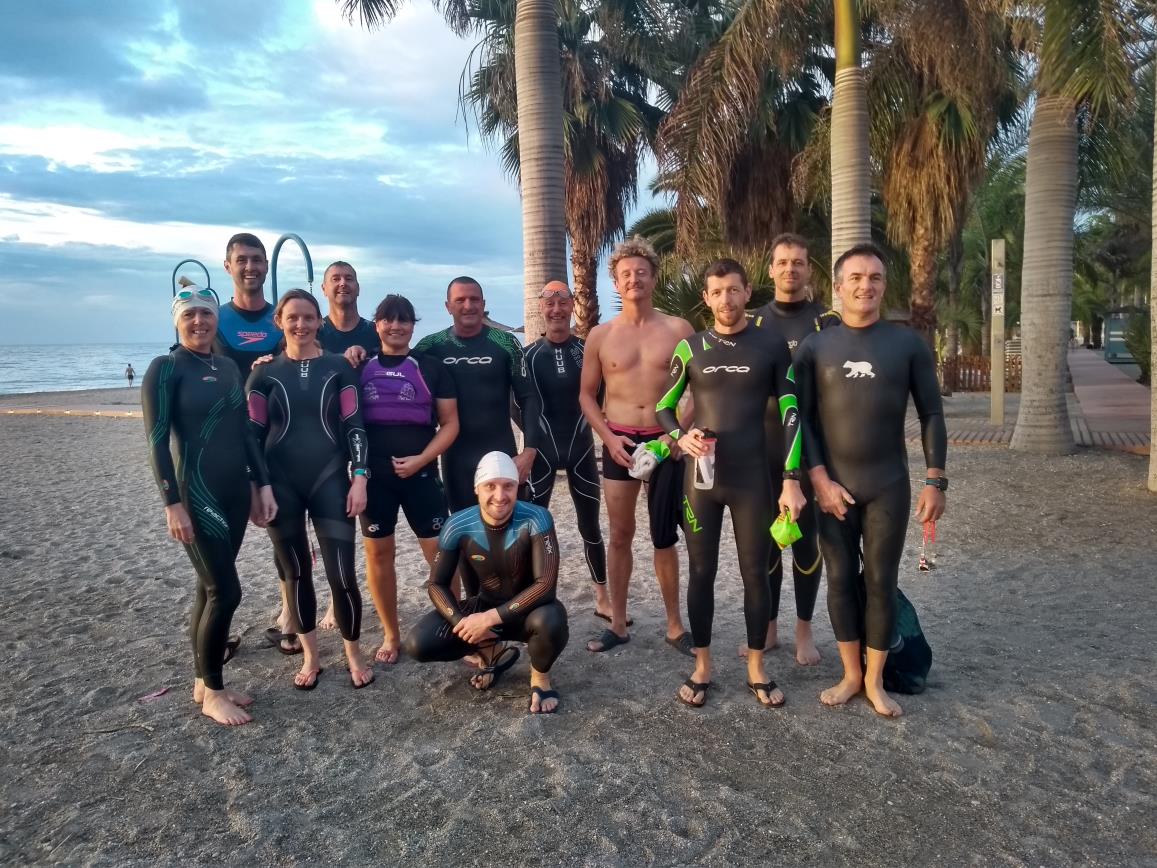
Open Water Swim Camp in Southern Spain with ChiliTri
